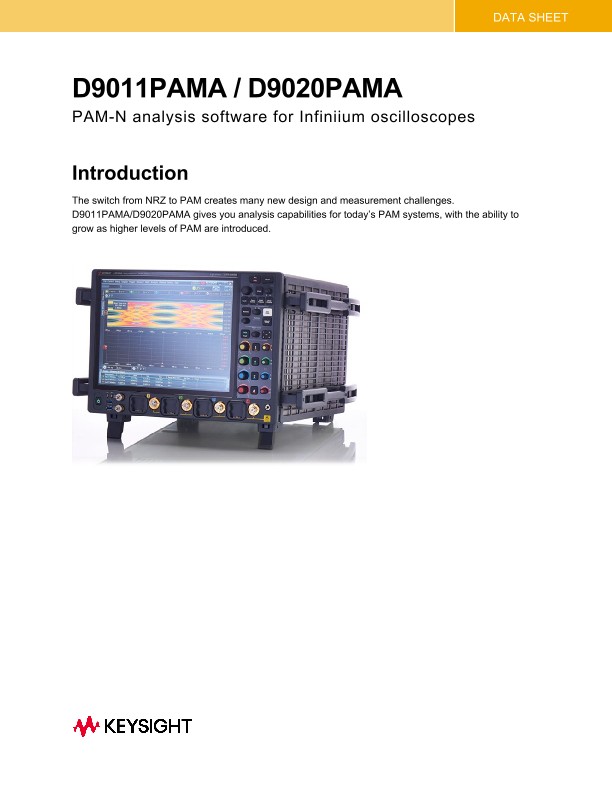Choose a country or area to see content specific to your location

데이터 시트
D9011PAMA / D9020PAMA
PAM-N analysis software for Infiniium oscilloscopes
Introduction
The switch from NRZ to PAM creates many new design and measurement challenges. D9011PAMA/D9020PAMA gives you analysis capabilities for today’s PAM systems, with the ability to grow as higher levels of PAM are introduced.
Product Overview
PAM (Pulse Amplitude Modulation) signals use more levels than the "high" and "low" levels of NRZ (nonreturn-to-zero) to achieve greater throughput with the same Baud rate. For example, PAM-4 uses 4 levels where each level represents 2 bits of data (00, 01, 10, and 11). Because the signal-to-noise ratio (SNR) of PAM signals is lower, they are more susceptible to noise.
To perform PAM level and rise/fall time measurements, the oscilloscope needs to determine the PAM levels and the thresholds that separate them. The oscilloscope needs to recover the clock from the PAM signal to display a real-time eye, make eye measurements, and perform jitter/noise measurements. Nonexplicit clock recovery methods require PAM signals with open eyes.
Because some PAM designs operate on links with BER of ~1E-5, equalization may be used to widen eye openings. Feed-Forward Equalization (FFE) of PAM signals requires open eyes to begin with. This is different from FFE of NRZ (non-return-to-zero) signals, where open eyes are not required to begin with. Decision Feedback Equalization (DFE) of PAM signals or NRZ signals requires open eyes to begin with.
The Keysight D90xxPAMA PAM-N analysis software extends the ease-of-use advantages of the Infiniium oscilloscopes to the analysis of PAM-3, PAM-4, PAM-6, and PAM-8 signals.
PAM-N Measurement Setup
The Signal Type Setup dialog box is where you launch the PAM measurements setup wizard or manually enter your PAM measurements settings. In Signal Type Setup, you can specify the type of PAM signal being measured and the nominal symbol rate. Moreover, in the new 11.x software(available for UXR and MXR-Series oscilloscopes) you can launch the SNDR Setup dialog box where you can set up SNDR measurements like Sigma-n, Sigma-e, Pmax, and SNDR. If PAM-4 is selected as the signal type, you can enable PAM-4 12 Edge Jitter measurements. For the SSPRQ100 Setup box, A UXR-Series oscilloscope can be used to deskew SSPRQ100 patterns from a Keysight A400GE test system(part of 400GBase FEC-aware receiver test solution).
A wizard walks you quickly through the steps required to set up measurements for a PAM encoded signal, select methods for clock recovery, and then the measurements you wish to have performed on your PAM signal. Our PAM software is also able to accurately set the individual threshold levels of your PAM signal and render each individual eye. The number of mask regions currently supported by Infiniium software is sufficient for up to PAM-8 signals, so mask testing works the same as with NRZ (non-return-to-zero) signals.
Noise or Data TIE (Jitter) Measurements
In D90xxPAMA PAM-N analysis software, you can do noise measurements for each level and jitter measurements for each threshold. You can specify the pattern length and measurement location within the bit where 0% is the beginning of the symbol, 50% is the middle of the symbols, and 100% is the end of the symbol. PAM threshold can be selected for which you want jitter measurements. You can also set the bit error rate (BER) value that is used in conjunction with BER Bathtub curve to calculate the total jitter(TJ) peakto-peak value displayed in the RJ/DJ tab.
×
판매 문의 부탁드립니다.
*Indicates required field
감사합니다!
A sales representative will contact you soon.